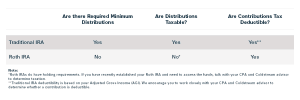
Insights
January 15, 2025
How Does a Backdoor Roth IRA Contribution Work?
In Tax Planning, Wealth Strategy

Backdoor Roth IRA contributions are a commonly used planning technique to help high-income earners contribute to a Roth IRA, even when their income is higher than the maximum set by the IRS. While the strategy is commonplace, the logistics are often misunderstood. This can lead to misconceptions and potential errors on tax return filings. In this article, we discuss the income limitations for direct Roth IRA contributions and the tax deductibility limitations for traditional IRA contributions.
Contribution Limits to Individual Retirement Accounts (IRAs)
Click here for current traditional and Roth IRA contribution limits, including catch-up limits for those aged 50 or older. You may also be eligible to contribute to an IRA in your spouse’s name even if he or she receives little or no earned income; learn more about the spousal IRA limit here. Contributions need to be made by the tax filing deadline of April 15th (note: tax extensions do not extend IRA contribution deadlines).
Roth IRA Versus Traditional IRA
As advisors, we are always excited about the opportunity to help clients contribute to Roth IRAs. Roth IRAs have several unique features that make them appealing; the main feature being tax-free growth. The table below summarizes the main differences between Roth and traditional IRAs.

Roth Income Limitations and Traditional IRA Deductibility
Due to income limitations placed on Roth IRAs, it is challenging for high-income earners to directly contribute funds to a Roth IRA. If your Modified Adjusted Gross Income (MAGI) exceeds the maximum, you are not allowed to directly contribute to a Roth IRA. Visit here to learn what the current Roth IRA income limitations are.
Additionally, traditional IRAs have income limitations for tax deductibility. Learn more about those income limitations here.
Solutions if Your Income is Over These Thresholds
The complexity of Roth IRA income limitations and Traditional IRA deductibility brings us to the concept of the backdoor Roth IRA contribution. The IRS currently allows high income earners to make an IRA contribution, and then subsequently convert that contribution to a Roth IRA.
Step One – Make a non-deductible IRA contribution. The contribution is not deductible for income tax purposes, but it is reported on your tax return on Form 8606. The contribution is made with funds on which taxes have already been paid, and these “after-tax” dollars creates basis in the IRA account. The Form 8606 is an information schedule included in your return that keeps track of all the “after-tax contributions” you’ve made over time.
Step Two – Roll the non-deductible IRA contribution into a Roth IRA. If you have no traditional IRA balances before making the backdoor Roth IRA contribution, you will have no income tax consequences (assuming there are no earnings on the non-deductible IRA contribution before the rollover to the Roth IRA). There is no income tax since you have basis in the IRA equal to your non-deductible contributions.
However, if you have large traditional IRA balances, the backdoor Roth IRA contribution may have unintended income tax ramifications.
Be Careful of The Pro-Rata Rule
The key reason the backdoor Roth IRA contribution works without creating a tax liability is because there are no pre-tax dollars already held in the traditional IRA. The IRS requires that a conversion from a traditional IRA to a Roth IRA be done on a pro-rata basis.
What this means: When determining the tax liability on a conversion, the IRS looks at all of your traditional, SIMPLE, and SEP IRA accounts combined. For example, if your accounts consist of 80% pre-tax dollars and 20% after-tax dollars, then that ratio determines what percentage of the money you convert to a Roth is deemed taxable. In this example, 80% of the conversion amount would be taxable.
Unfortunately, you cannot choose to convert only after-tax money. The IRS applies the pro-rata rule to your total IRA balance at year-end, not at the time of conversion. It is worth noting that 401(k)s ― even self-employed 401(k)s ― and IRAs you may have inherited from someone else are not included in the pro-rata calculation.
If you would like to explore whether a backdoor Roth IRA contribution is right for you, please reach out to your Coldstream team. We will work closely with you and your tax advisor to make sure it makes sense for your situation and you have the proper documentation to report your backdoor Roth IRA contribution.
*All of Coldstream’s staff shall attain the required licenses and designations necessary for his/her position. Certified Financial Planner Board of Standards Inc. owns the certification marks CFP® and Certified Financial Planner™ in the U.S.
DISCLAIMER: THIS ARTICLE HAS BEEN PROVIDED FOR INFORMATIONAL PURPOSES ONLY AND SHOULD NOT BE CONSIDERED AS INVESTMENT ADVICE OR AS A RECOMMENDATION. THIS MATERIAL PROVIDES GENERAL INFORMATION ONLY. coldstream DOES NOT OFFER LEGAL OR TAX ADVICE. ONLY PRIVATE LEGAL COUNSEL or your tax advisor MAY RECOMMEND THE APPLICATION OF THIS GENERAL INFORMATION TO ANY PARTICULAR SITUATION OR PREPARE AN INSTRUMENT CHOSEN TO IMPLEMENT THE DESIGN DISCUSSED HEREIN. CIRCULAR 230 NOTICE: TO ENSURE COMPLIANCE WITH REQUIREMENTS IMPOSED BY THE IRS, THIS NOTICE IS TO INFORM YOU THAT ANY TAX ADVICE INCLUDED IN THIS COMMUNICATION, INCLUDING ANY ATTACHMENTS, IS NOT INTENDED OR WRITTEN TO BE USED, AND CANNOT BE USED, FOR THE PURPOSE OF AVOIDING ANY FEDERAL TAX PENALTY OR PROMOTING, MARKETING, OR RECOMMENDING TO ANOTHER PARTY ANY TRANSACTION OR MATTER.
Insights Tags
Related Articles

July 9, 2025
The “One Big Beautiful Bill”: Key Tax Provisions



June 27, 2025
Diversified Estate Planning for LGBTQ+ Families


June 20, 2025
Incorporating a “Die with Zero” Philosophy into Your Long-Term Financial Plan

